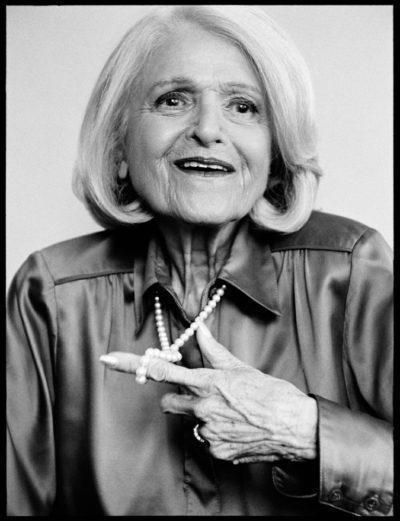Edith Windsor (Edith Windsor)

During college, Edith met Saul Windsor. Their relationship ended at one time during the engagement when Windsor fell in love with a female classmate. However, after Windsor decided she did not want to live life as a lesbian, they reconciled and got married after graduation. They divorced less than one year afterward, and she confided in him that she longed to be with women. Shortly after her divorce, Windsor left Philadelphia for New York City. Edith Windsor met Thea Spyer, an Amsterdam-born psychologist, in 1963 at Portofino, a restaurant in Greenwich Village. When they initially met, each was already in a relationship. They occasionally saw each other at events over the next two years, but it was not until a trip to the East End of Long Island in the late spring of 1965 that they began dating each other. To help keep the relationship a secret from her co-workers, Windsor invented a relationship with Spyer’s fictional brother Willy — who was actually a childhood doll belonging to Windsor — to explain Spyer’s phone calls to the office. In 1967, Spyer asked Windsor to marry, although it was not yet legal anywhere in the United States. Fearing that a traditional engagement ring might expose Windsor’s sexual orientation to her coworkers, Spyer instead proposed with a circular diamond pin. Six months after getting engaged, Edith Windsor and Spyer moved into an apartment in Greenwich Village. In 1968, they purchased a small house on Long Island together, where they went on a vacation for the following forty summers. The couple often took trips both in the United States and internationally. They also entertained at their home frequently, with Spyer preparing meals, including an annual Memorial Day weekend celebration of their anniversary.
In 1977, Spyer was diagnosed with progressive multiple sclerosis. The disease caused a gradual, but ever-increasing paralysis. Windsor used her early retirement to become a full-time caregiver for Spyer, and the couple continued to adjust their daily behavior to accommodate. Edith Windsor and Spyer entered a domestic partnership in New York City in 1993. Registering on the first available day, they were issued certificate number eighty. Spyer suffered a heart attack in 2002 and was diagnosed with aortic stenosis. In 2007, her doctors told her she had less than a year to live. New York had not yet legalized same-sex marriage, so the couple opted to marry in Toronto, Canada, on May 22, 2007, with Canada’s first openly gay judge, Justice Harvey Brownstone, presiding, and with the assistance of a filmmaker and same-sex marriage activist familiar with the laws in both countries. An announcement of their wedding was published in the New York Times. Spyer died from complications related to her heart condition on February 5, 2009. After Spyer’s death, Windsor was hospitalized with stress cardiomyopathy. On September 26, 2016, Edith Windsor married Judith Kasen at New York City Hall. At the time of the wedding, Windsor was age 87 and Kasen was age 51.She was also a member of the non-denominational Congregation Beit Simchat Torah synagogue, which has been self-described as the world’s largest LGBT synagogue.
Upon Spyer’s death on February 5, 2009, Windsor became the executor and sole beneficiary of Spyer’s estate, via a revocable trust. Windsor was required to pay $363,053 in federal estate taxes on her inheritance of her wife’s estate. Had federal law recognized the validity of their marriage, Windsor would have qualified for an unlimited spousal deduction and paid no federal estate taxes. Edith Windsor sought to claim the federal estate tax exemption for surviving spouses. She was barred from doing so by Section 3 of the Defense of Marriage Act (DOMA) (codified at 1 U.S.C. § 7), which provided that the term “spouse” only applied to marriages between a man and woman. The Internal Revenue Service found that the exemption did not apply to same-sex marriages, denied Windsor’s claim, and compelled her to pay $363,053 in estate taxes. In 2010 Edith Windsor filed a lawsuit against the federal government in the U.S. District Court for the Southern District of New York, seeking a refund because DOMA singled out legally married same-sex couples for “differential treatment compared to other similarly situated couples without justification.” A subsequent 2012 ruling by Judge Barbara S. Jones ruled that Section 3 of DOMA was unconstitutional under the due process guarantees of the Fifth Amendment and ordered the federal government to issue the tax refund, including interest. The U.S. Second Circuit Court of Appeals affirmed in a 2-1 decision later in 2012. The U.S. Supreme Court heard oral arguments in the case from March 2013 and subsequently issued a 5–4 decision declaring Section 3 of DOMA to be unconstitutional “as a deprivation of the liberty of the person protected by the Fifth Amendment.” in June of that year.
Born
- June, 20, 1929
- USA
- Philadelphia, Pennsylvania
Died
- September, 12, 2017
- USA
- New York, New York



